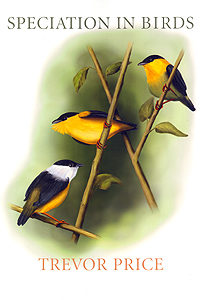Price synthesizes bird speciation studies, examining nearly 10,000 bird species
By Maja FiketMedical Center Communications
 | |
A University biologist and world-renowned expert on bird speciation has compiled eight years of research and writing into a new book, Speciation in Birds.
Trevor Price, Professor in Ecology & Evolution, evaluates the contributions of sexual selection and natural selection in bird speciation, and the roles of geographical isolation, ecological differentiation and genetic drift. He discusses how nearly 10,000 bird species originated and which factors influenced this process. The author also reviews many publications on bird speciation, with more than 1,000 works cited.
“As the literature in any field explodes, there is simultaneously an increasing need for synthesis yet an increasing difficulty in achieving it,” said Peter Grant, ecology and evolution professor at Princeton University. “This is certainly true for the ever-popular subject of ornithology. Trevor Price takes up the challenge to explain how birds speciate and succeeds magnificently.”
Price discusses the biological species concept, whereby species are defined as “groups of interbreeding populations, reproductively isolated from other such groups.” He explains when the biological species concept works well and when it needs to be modified. He analyzes causes of pre-mating- and post-mating reproductive isolation, and explains why reproductive isolation is probably the most crucial component of evolution.
“Without reproductive isolation,” Price said, “only one species would be found at each location in the world, placing a severe limit on the total number of species.”
This book deals with many other questions, including: Which factors contributed to species diversity? How did these factors lead to huge bird diversity in South America, the continent with almost one-third of the world’s bird species? And what led to endemism—species generation in a particular region, such as on isolated islands?
According to Price, the idea for this book came in 1997 with an invitation from the organizers of a Royal Society of London meeting to review sexual selection and speciation. The literature was diverse and too scattered for a proper review, so “I set about doing this in a more systematic way,” he said.
“Speciation in Birds is a significant advance in our understanding of the genesis and maintenance of biological diversity,” remarked evolutionary biologist Jonathan Losos of Harvard University. “It will be a must-read not only for ornithologists, but for evolutionary biologists of all stripes.”
Price earned a B.S. from the University of Cambridge and a Ph.D. from the University of Michigan. He was a postdoctoral fellow at Chicago in 1984, when he received the American Society of Naturalists Young Investigator’s Award.
He also received a John Simon Guggenheim Memorial Foundation fellowship for research in 2005 and the E.O. Wilson Naturalist Award in 2007.
His fieldwork has been based in India for the past 30 years, most recently in northeast India, an area with many endemic bird species and one of the world’s top areas in bird diversity.
![[Chronicle]](/images/sidebar_header_oct06.gif)